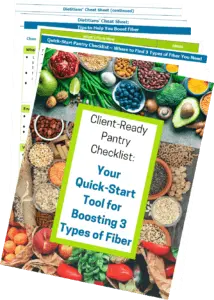
Can Too Many Choices Promote Overeating? What You Can Do
A buffet laden with dish after dish – whether it’s at an all-you-can-eat restaurant or a party – is something most of us recognize as an occasion that easily pushes us to eat more than usual. Yet is it possible that variety in your day-to-day life also pushes you in directions that work against your goals of healthy eating?
In a now-classic experiment, food psychology research at Cornell University found that people given a bowl of M & M candies in 10 different colors ate more candy than people given the same number in only seven colors. It’s a good guess that everyone knew that all these M & Ms tasted exactly the same. Yet somehow, the perception of variety led to more eating.
If you’ve been looking for ways to cut back on less healthful foods or to reduce your overall calorie consumption, you can put the research on variety’s impact to work for your good health.
How Too Many Choices Can Prompt Overeating
Back in my grad school days at Cornell, I was intrigued to learn that “cafeteria diets” containing a variety of high-fat, high-calorie snack foods could dramatically increase animals’ calorie consumption compared to usual lab chow. Back then, it was assumed this was showing the effect of the types of foods included.
- Since then, animal studies show that even when fat and carbohydrate content are the same, simply providing greater variety in flavor and texture also leads animals to consume more calories.
- In experiments with people, meals with a greater variety of foods leads to increased calorie consumption compared to offering the same amount of all the same food, even if the single food is a favorite.
- When looking at eating spread across several days, people also eat more food when there is more variety. When that reflects greater variety in foods higher in calories, it can lead to increased calorie consumption. For example, in one study, a greater “variety ratio” of variety in sweets, snacks, condiments, entrées, and carbohydrates compared to variety in vegetables, was linked to greater percent body fat. Another study found that limiting variety of snack food choices as part of a reduced-calorie diet could be at least as effective in reducing total daily calories as focusing on limiting snack food servings.
Where is Variety Making Healthy Harder for You?
Where is the greatest variety in your eating habits? Here are two ways to consider whether the amount and sources of variety in the foods you eat are creating barriers to healthy eating:
- Look through your cupboards, refrigerator and freezer. Especially focus on the types of foods you’re trying to eat less often. How much variety is there prompting you to eat more?
- Keep a record of everything you eat for a week or two. At the end of that time, look through and count how many different kinds of less healthy foods you ate compared to the variety of fruits and vegetables.
If the thought of recording everything you eat for so long seems overwhelming, you might focus on one particular category of foods you think may be unhealthfully high in your diet – maybe sweets, snack foods, or refined grains, for example.

Limiting variety of high-calorie, low-nutrient foods on hand and at each meal makes it easier to keep a health-promoting balance
How to Tweak Variety to Make Healthy Eating Doable
If you discover that some of the foods on which you’ve been trying to cut back are the foods identified in your survey in frequent variety, experiment with how reducing variety might make it easier for you to limit these foods and cut excess calories.
Refined Grains
♦ If you bake or buy muffins, select one type rather than a variety to make it easier to eat just one.
♦ If you’re going to serve a refined grain like regular pasta or white rice, don’t serve white bread, too. Most people don’t cut back enough on one to compensate for eating yet another kind of refined grain.
♦ Potatoes are a vegetable, not a grain. However, their carbohydrate and calorie content is like that of a grain. So choose potatoes or a bread product like rolls or biscuits, not both. If you go out for breakfast, choose potatoes or toast, not both. If you get a sandwich or burger, have the bread or roll or the fries, not both.
[**Note: the need to limit grain product servings so carefully does not apply to athletes with very high calorie needs who need large amounts of carbohydrate as part of their total high calorie intake. For optimal nutrition, even these athletes would do better to limit refined grains and choose whole grains more often, but they usually do not need to cut back on total grain products. Most of us are not in this category, however – simply taking a walk every day does not put you in the category of an athlete with high calorie needs.]
Snacks and Desserts
♦ Keep one kind of ice cream or frozen yogurt in the freezer at a time. More variety encourages you to eat more. What’s more, people tend to eat more when there’s a bigger “stash” on hand. Grocery store sales and coupons can make us think we save money by buying two cartons of ice cream at once. But most of the people with whom I’ve worked who tracked it found they actually went through the ice cream just as fast (because they ate more), and they did not spend any less money.
*If you really want to take advantage of a two-for-one deal on a food you’re trying to limit, split the purchase with a friend. That way you truly save money because you spend less without eating more.
♦ Choose no more than one or two kinds of crackers, chips, cookies or other processed snack foods to have on hand at one time.
*Establish the habit – or the understanding with the rest of your family – that once the snack food supply is gone, it won’t be replaced until the next designated shopping day. That is, if on day one after shopping the whole bag of chips is gone, don’t automatically run out to buy more the next day. When the easy choice is gone, people tend to turn to another option (like a piece of fruit?), or decide they weren’t actually hungry after all.
♦ If you are a dessert-lover, trying to completely give up desserts can lead to a feeling of deprivation that leads to overeating. However, don’t make it harder on yourself than it has to be to limit desserts to reasonable portions. When faced with the option of a dessert buffet or ordering a single dessert, order one and slowly savor every bite.
*In fact, when they really savor and enjoy – guilt-free – a serving of dessert, many people find that the first few bites are the real ecstasy. They find the rest is good, but no longer sends them over the moon. That’s why sharing a dessert works so well. You enjoy those first few tremendous bites, and skip the ones that you don’t miss later.
Other Places Variety Hurts
♦ Red meat, processed meat and deep-fried, high-fat meat all should be limited, either because of the excess calories or the more direct threats to health such as increased risk of colorectal cancer and heart disease. So, for example, if you can’t stand the thought of pizza without meat, choose: sausage or pepperoni, not both. (And preferably neither!)
♦ Sugar-laden soft drinks are a source of excess calories, and regular consumption is linked to long-term health risks. Limit the number of choices and the amount you keep on hand to reduce the “pull” to consider these a normal daily beverage option.
*If you crave variety, instead keep a stash of different flavors of tea. Perhaps keep a pitcher of home-brewed tea in the refrigerator, varying the type of tea (which could include fruit-flavored herbal teas) as a way of providing variety in beverage choices in a more healthful way. Flavors of fruit-infused water you keep in a pitcher can rotate for variety, too.
Is Variety Always Unhealthy?
No! In fact, a variety of healthful foods can do a lot to make healthy eating easier to accomplish and more fun. Come back for part 2 on this topic. – We’ll look at the positive ways to use variety to support your health goals. Sign up to receive my research reviews by email here!
Meanwhile, take a look at how too much of the wrong kind of variety might be working against you. What one step can you test out as a way to make healthy eating more doable for you?
⇒ Free Client-Ready Checklist:
Variety in the Diet: How to Turn Barriers to Benefits
Now that you the pitfalls of the wrong kind of variety, get this checklist to find opportunities and ideas to tweak the spots where too many choices pose a barrier – and find spots where boosting variety could help, too.
Just click here.
You’ll get this practical checklist of tips… and receive future nutrition research reviews direct to your email inbox.
The Cornell Food and Brand Lab has identified lots of ways that we can use variety and other environmental cues to make healthy eating easier in schools, the workplace and at home. Fun to read and exciting to implement!
Kahn BE, Wansink B. The Influence of Assortment Structure on Perceived Variety and Consumption Quantities. Journal of Consumer Research. 2004; 30:519.
Raynor HA. Can limiting dietary variety assist with reducing energy intake and weight loss? Physiol Behav. 2012;106(3):356-61
Wadhera D, Capaldi-Phillips ED. A review of visual cues associated with food on food acceptance and consumption. Eat Behav. 2014 Jan;15(1):132-43.
5 Comments
Leave a Comment
Published : February 20, 2014 | Last Updated: September 21, 2021
Tagged: healthy diet, healthy eating, obesity, reducing cancer risk, snacks, sweets, variety, weight control, weight loss
Meet the author/educator
I Take Nutrition Science From Daunting to Doable.™
As a registered dietitian nutritionist, one of the most frequent complaints I hear from people — including health professionals — is that they are overwhelmed by the volume of sometimes-conflicting nutrition information.
I believe that when you turn nutrition from daunting to doable, you can transform people's lives.
Accurately translating nutrition science takes training, time and practice. Dietitians have the essential training and knowledge, but there’s only so much time in a day. I delight in helping them conquer “nutrition overwhelm” so they can feel capable and confident as they help others thrive.
I'm a speaker, writer, and nutrition consultant ... and I welcome you to share or comment on posts as part of this community!



[…] See the article here: Variety? Why it could be making <b>healthy eating</b> harder | Smart Bytes […]
[…] Variety? Why it could be making healthy eating harder […]
You do the people who read this dibble a grave injustice. It appears that you are nothing but a shill for some of the products you rated.
High Fructose is not just another sugar and saying sugar is just sugar you need to widen your horizons to the testing that is done not by the maker, but those who care about safety. In the movie KING CORN they covered the GMO corn processed by Sulfuric acid and a woman who runs a feed lot and feeds her cattle the residue from that sugar making plant. Stated that they could only keep the cattle in the lot for between 130 to 140 days as if not sent to slaughter they DIED. They had at least one of the cattle with a 4 inch diameter poly tube that allowed them to reach into the animal and draw up stomach contents. It is an interesting movie you should watch it and learn about what you really don’t seem to know/
Clifford, thank you for taking the time to join in the discussion here.
I agree with you that it’s a real challenge for people who want to make smart choices for a healthy lifestyle, as they try to find solid information on which to base those choices. There is a lot of information out there that is paid for by special interests, and also a lot that is published by people with good intentions but without background in science. It can be very hard when someone sees a few published papers to know whether they truly represent the “big picture” of research, or if they are the exceptions.
Actually, that is the motivation that inspired me to create and keep up this blog. I make absolutely no money from doing it, and spend hours and hours each week searching out and studying available research to be able to create summaries that I hope will help people. If you look around, you’ll see there are no advertisements of any kind (unlike many places people are reading their nutrition information), and I accept no sponsorship of these posts.
I am confused as to what gives you the impression that I don’t read widely divergent nutrition views. I do, and have viewed a number of movies (as you note) that address concerns about our food system today, because it’s a topic about which I do care. I also don’t know what gave you the impression that I encourage people to eat more sweets. This post about which you’re commenting is completely about the message that most Americans are eating too many foods high in sugar and low in nutrition. I’m writing with tips about how people can set up eating patterns and their home and work environment to make it easier to eat healthfully.
The approach that works for one person to move to healthier choices can be different than the approach that works for someone else. Some may completely abstain from anything that is not solid A+ nutritionally. Others are not willing to make that big a change, or try and cannot sustain it.
I’m sorry to hear that you believe I do not look at the big picture of research before expressing what I see as the take-home message. I can only say that I accept that not everyone will agree with the conclusions I draw, and that doesn’t keep me from doing my best.
For more from someone else who is far more in the public eye than I, I’ll say that I agree with much of what is expressed in a recent Huffington Post column by David Katz, MD on “iDietology”: http://www.huffingtonpost.com/david-katz-md/idietology_b_5096690.html?utm_source=Alert-blogger&utm_medium=email&utm_campaign=Email%2BNotifications
All who are interested in positive and respectful conversation are welcome to converse in dialogue here.
[…] and its effects on weight gain and weight loss – see Part 1 of my previous Smart Bytes about the ins and outs of […]